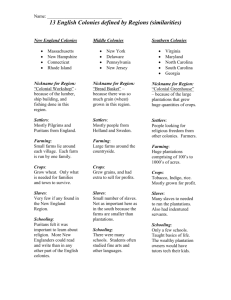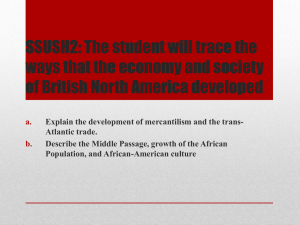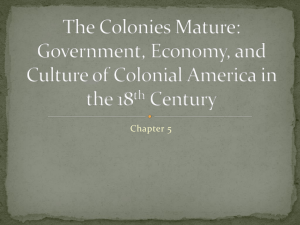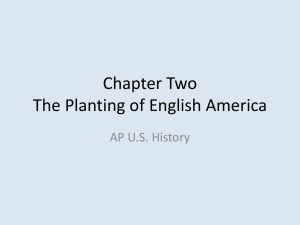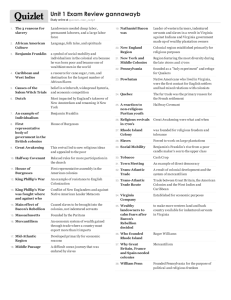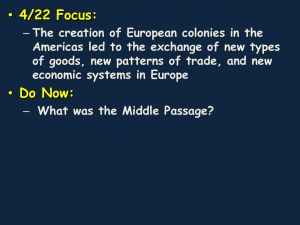Chapter_3_England_and_Its_Colonies_Answered
advertisement
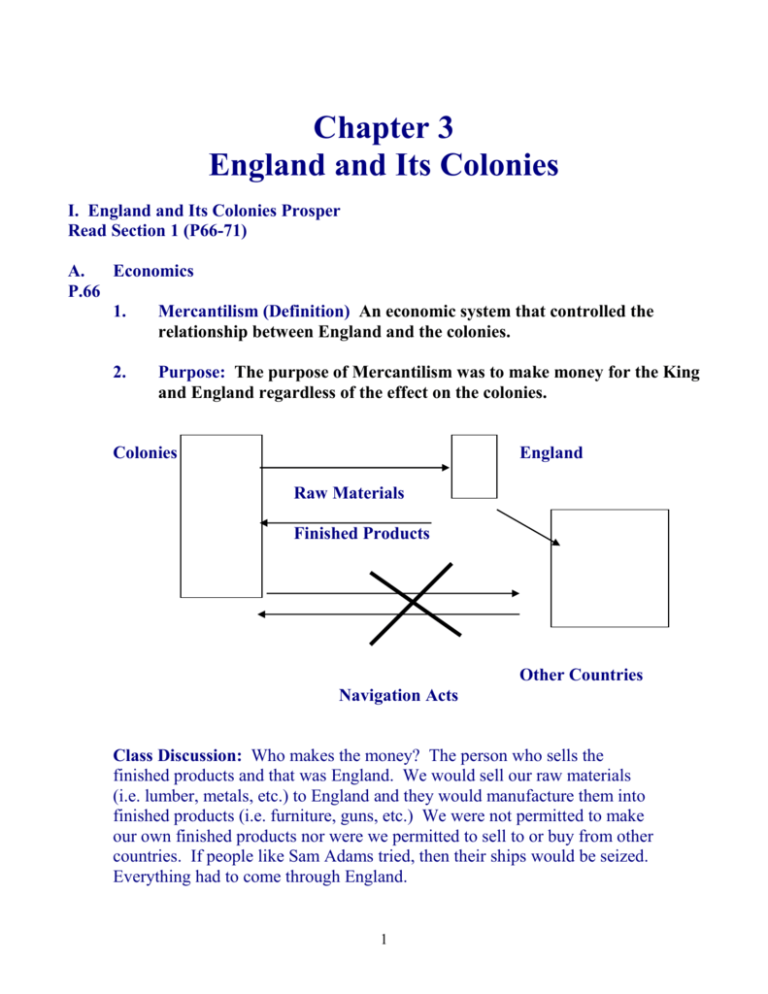
Chapter 3 England and Its Colonies I. England and Its Colonies Prosper Read Section 1 (P66-71) A. Economics P.66 1. Mercantilism (Definition) An economic system that controlled the relationship between England and the colonies. 2. Purpose: The purpose of Mercantilism was to make money for the King and England regardless of the effect on the colonies. Colonies England Raw Materials Finished Products Other Countries Navigation Acts Class Discussion: Who makes the money? The person who sells the finished products and that was England. We would sell our raw materials (i.e. lumber, metals, etc.) to England and they would manufacture them into finished products (i.e. furniture, guns, etc.) We were not permitted to make our own finished products nor were we permitted to sell to or buy from other countries. If people like Sam Adams tried, then their ships would be seized. Everything had to come through England. 1 P.68 3. Navigation Acts: (Definition) Laws that enforced mercantilism. They permitted America ONLY to trade w/ England and limited what we could make. 4. Parliament (Definition) The English legislature that passed the Navigation Acts. B. England Loosens the Reins P.70 1. Salutary Neglect (Definition) Prior to the French & Indian War, England did not enforce mercantilism or the Navigation Acts. 2. Why does Salutary Neglect plant the seeds of Self-Government: America passed its own laws and did as it pleased. When England began enforcing the Navigation Acts, Americans resented it. (Teenager Analogy). II. The Agricultural South Read Section 2 (P.72-78) A. A Plantation Economy Arises P.72 1. Cash Crop Definition: Those crops farmers grow to sell for cash rather than to use themselves. MD, VA, NC SC, GA Tobacco Rice and later Indigo 2. Type of farms in the South: Plantations B. Life in Southern Society (Pre-Revolution) P.73-75 1. Role of Women: Did not have rights. Could not vote or own property. Provided very little education. Subservient to husbands. 2 2. Social Hierarchy: Aristocratic Plantation Owners called Planters (5%) Small White Farmers White Indentured Servants African Slaves C. Slavery and the Triangular Trade (P. 76) America Food Rum, etc. Sugar, Molasses Slaves Africa Middle Passage D. W. Indies Middle Passage The journey African slaves were taken from Africa to the West Indies and then America How many died along the way? 20% See Illustration of Slave Ship P. 76 Read Narrative of Slave P. 76 3 III. Section 3 The Commercial North (Middle Colonies and New England Colonies) Read section 3 Pp 79 – 84 A. Comparison Types of Farms B. South Plantations North Small Farms Farms Produced Tobacco, Rice, Cotton, Wheat, Corn Indigo Cattle, hogs, etc Along Rivers Plantations developed. Small Towns and later Factories. Ethnicity Mostly WASP – White, Huge variety of Anglo-Saxon, European Immigrants. Protestant. Most immigrants came to the North. Some Germans and See Chart on next page. 40-60% African. Ethnicity of Colonies (P.81) English 52% Scotts-Irish 7% African 20% Irish 5% 4 German 7% Scottish 4% See Chart on P. 81 Read “Nativist” sentiment from Benjamin Franklin. Nativist = Anti-Immigrant. Favored Native born C. Note: Do not confuse w/ Native Americans which means American Indians The Age of Enlightenment 1. What was it? A time period when people looked to Reason and Science for answers on how the world worked rather than religion. 2. Key Enlightened Europeans: Nicolaus Copernicus, Galileo Galilei, Sir Isaac Newton. 3. Key Enlightened American: Benjamin Franklin His famous experiment? Discovered lightening was electricity 4. Why do we learn about the Age of Enlightenment? It caused the founding fathers to question the authority of England and the King and develop the belief in natural rights. 5
